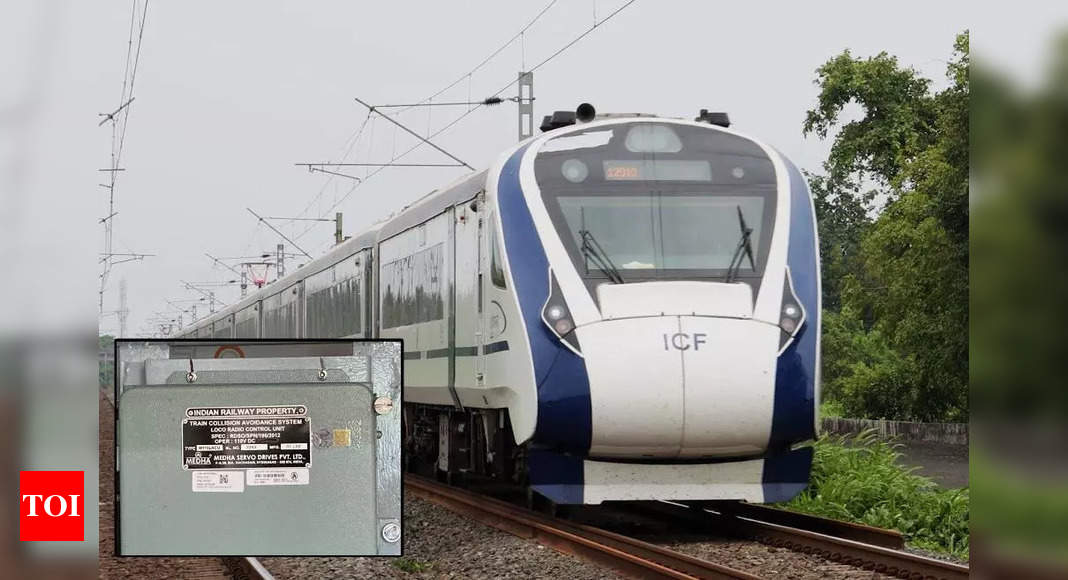The brand new Vande Bharat Categorical prepare service between Gandhinagar in Gujarat and Mumbai in Maharashtra flagged off just lately by PM Modi marked the growth of recent age, quick prepare providers.
It additionally marked an intensification of security measures within the Indian Railways.
The 160 kmph succesful Vande Bharat 2.0 is supplied with the Kavach, a ‘Make in India’ security system developed to attain the intention of zero accidents.
The brand new know-how, mentioned to be at par with the European Practice Management System (ETCS) – 2, is slated to be a game-changer for making certain protected prepare journey.
Trying to improve security, Indian Railways says it has been working to deliver down rail accidents with vital progress made in the previous couple of years.
The variety of passenger fatalities within the consequential prepare accidents stood at zero over 2019-20 and 2020-21, claims authorities information.
All unmanned degree crossings have been eradicated, and railways is quick changing outdated ICF-design coaches with LHB ones which have anti-climbing options to minimise casualties in case of derailment or collision.
Railways can also be working to improve its signalling infrastructure and have in place a contemporary prepare safety system to keep away from collisions.
Kavach is a signficant initiative on this mission to make and maintain Indian Railways accident free.
So, what’s Kavach?Kavach is an indigenously developed Automated Practice Safety system developed by the Analysis Design and Requirements Organisation (RDSO) in collaboration with the Indian trade.
Indian Railways claims that Kavach is “one of many least expensive”, Security Integrity Degree 4 (SIL-4) licensed applied sciences with the likelihood of error being 1 in 10,000 years.
To place it merely, Kavach is supposed to offer safety by avoiding a collision between two trains.
The system prompts the prepare braking system robotically if the motive force fails to regulate the prepare as per the pace restrictions, claims Indian Railways.
It prevents a collision between two locomotives outfitted with a purposeful Kavach system.
Kavach sensors on prime of driving coach of Vande Bharat ExpressHere are some salient options of Kavach:1.
Centralized stay monitoring of prepare actions by community monitor system 2.
Prevention of collision between two locomotives/self-propelled trains outfitted with purposeful Kavach 3.
Automated braking for prevention of over dashing 4.
Prevention of Sign Passing at Hazard 5.
Auto whistling whereas approaching degree crossing gates 6.
SoS messages throughout emergency conditions In March this 12 months, Railway Minister Ashwini Vaishnaw witnessed the Kavach trial between Gullaguda-Chitgidda railway stations in South Central Railway.
Through the trial, a head-on-collision scenario was created, with two locomotives transferring in the direction of one another.
The Kavach system initiated the automated braking system, therefore halting the locomotives 380 metres aside.
One other function to be examined was crossing at purple sign, whereby the locomotive didn’t cross the purple sign as Kavach necessitated the applying of brakes robotically.
Is Kavach a game-changer for rail security?In response to Sudhanshu Mani, the person behind Practice 18, the Kavach system is “definitely a game-changer” because it has the potential to enhance security, improve line capability and improve the pace of operation.
“It (Kavach) significantly enhances the hassle of Indian Railways to extend its most and common speeds,” Mani instructed TOI.
“Its marriage in future trains like Vande Bharat is sort of logical,” the retired GM of ICF mentioned.
Lalit Trivedi, Adviser Rail Expertise at IISC stresses on the truth that the brand new know-how can’t work if solely a fraction of locomotives and self-propelled trains are supplied with this tools.
“For the whole community comprising round 15,000 locomotives & self-propelled trains, 70,000 kms rail route, 7,000 railway stations, 15,000 degree crossings, the estimated value of protection of this method over the whole size and breadth of Indian Railways will likely be upwards of Rs 1 lakh crore,” he tells TOI.
Kavach Automated Practice Safety systemHowever, Indian Railways has mentioned that after applied, Kavach will likely be among the many world’s least expensive computerized prepare collision safety techniques.
Railways has mentioned that the brand new system prices Rs 50 lakh per kilometre to function in comparison with about Rs 2 crore worldwide.
The nationwide transporter can also be hopeful of the export potential of the brand new indigenous know-how.
Agrees Mani, including that the system will save an enormous amount of cash for the nation, vis-a-vis an equal ETCS-level 2 system.
Kavach on Indian Railways community:The intention is to implement the system on 2,000 kilometres through the present monetary 12 months on excessive density routes like New Delhi–Mumbai and New Delhi–Howrah routes.
The system will likely be additional prolonged to an extra 4,000 to five,000 kms from subsequent monetary 12 months.
The plan is to cowl these two routes by March 2024.
Additional roll out will likely be deliberate based mostly on the expertise gained.
Consultants are of the view that Indian Railways must deal with enhancing roll out time strains and increasing attain throughout the community.
“For Kavach to be efficient, the Kavach tools must be obtainable on all locomotives or self propelled automobiles working on the route,” says Lalit Trivedi.
“All stations and Degree crossings enroute ought to have this tools, apart from availability of devoted fibre coupled with RFID tags all alongside the route,” he explains.
Trivedi, who retired because the GM of East Central Railway says that even on these two routes, hardly 10% of locomotives and self propelled trains have Kavach.
“No security will likely be obtainable as the potential of a Kavach-fitted locomotive with a non-Kavach fitted locomotive will likely be greater than 90%,” he tells TOI.
Sudhanshu Mani says that with Delhi-Mumbai and Delhi-Howrah sections slated to be match for 160 kmph trains, Kavach’s implementation must maintain tempo.
“Not solely that, we also needs to roll it out in different sections too to use and maintain its super advantages early.
The hurdles are nothing however contractual points and IR forms ought to take care of it in a dedicated and purposeful method,” he provides.
.



Comment here